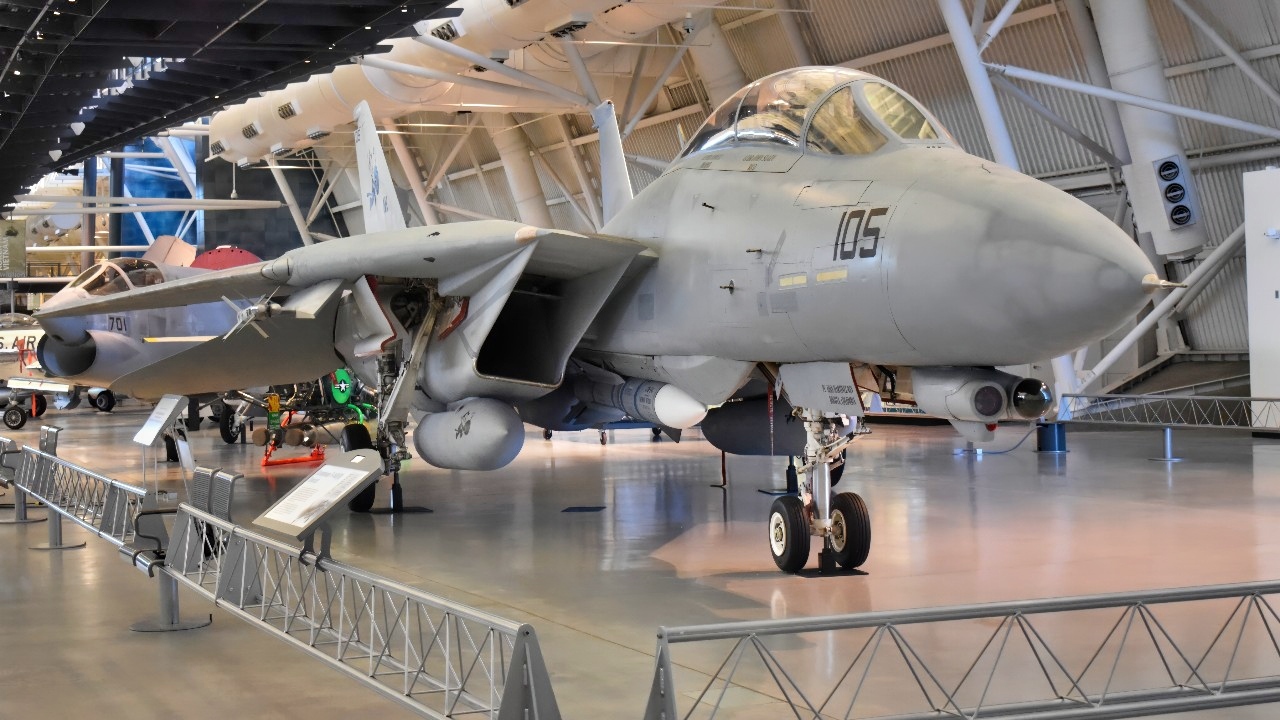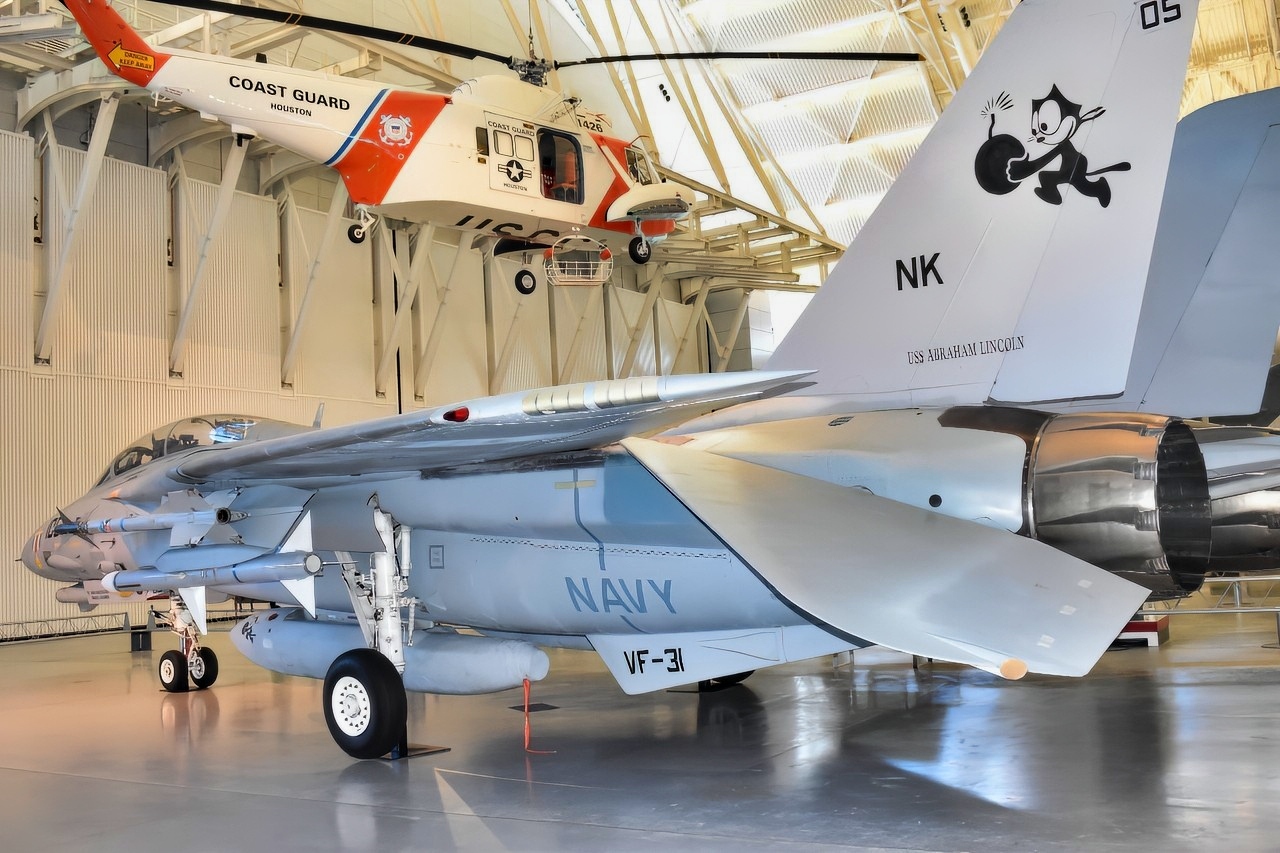Key Points and Summary – Born for Cold War fleet defense, the F-14 Tomcat married variable-sweep wings with the Hughes AWG-9 radar and AIM-54 Phoenix to swat bombers at 100+ miles while staying nimble for dogfights.
-Early TF30 engines were temperamental, but later F110 powerplants unlocked reliable thrust and better performance.

F-14D Tomcat Fighter Image from National Security Journal
-With a two-crew cockpit for superior situational awareness, the Tomcat intercepted Soviet aircraft, scored kills over Libya, and later adapted for precision strike.
-Though retired in 2006, its blend of reach, sensors, and agility—and its Top Gun fame—cemented the F-14 as one of naval aviation’s most iconic fighters.
Why Did The Navy Love The F-14 Tomcat?
U.S. Navy pilots loved the F-14 Tomcat for its unmatched long-range fleet defense capabilities; its high-speed; its high-altitude interceptor performance with powerful AIM-54 Phoenix missiles; and its versatile variable-sweep wings that provided agility for dogfights and speed for high-speed flight.
Its powerful radar, capable of tracking multiple targets simultaneously, and the two-man crew with its enhanced situational awareness, made the Tomcat a dominant air superiority fighter.
The variable-sweep wing design, combined with advanced fire-control systems and the AIM-54 Phoenix missile, made the F-14 capable of engaging multiple targets at long distances while still performing close-in combat and engaging in dogfights.
The Tomcat was born from the Cold War, at a time when the Navy expected the Soviets to flood the skies over the world’s oceans with bombers, which would fire fusillades of missiles at the Navy’s carrier task forces.

F-14D Tomcat Fighter NSJ Original Image. Taken by Dr. Brent M. Eastwood.
The missile defenses on U.S. ships were very effective, but the ships needed advanced fighters to defend against the bombers and engage the fighters accompanying them.
Meet The F-14 Tomcat
The 1970s was the golden age of U.S. aviation. During that decade, the United States developed three outstanding fighter aircraft that are still in use 50 years later.
The U.S. Air Force developed the F-15 Eagle and the F-16 Falcon, both of which the service still operates, with modern variants visually indistinguishable from the originals. The Navy developed the F-14 Tomcat, which may or may not still have a few flyable versions left in Iran – Israeli air strikes in June may have destroyed the final few models.
When discussions began about replacing the F-4 Phantom in the Navy’s carrier air wings, the F-111 Aardvark, the Air Force’s fighter-bomber, was evaluated. Developing a naval variant would have allowed for commonality between the Air Force and the Navy; however, the Aardvark was far too heavy for carrier operations.
The Navy instituted the VFX program to address the issue. Grumman designed its Model 303, which proposed a variable-geometry, two-seat, twin-engined design built around the Hughes AWG-9 weapon system.
Grumman had gained considerable experience with swing-wing technology from its earlier XF10F Jaguar prototype. However, the wing design of the A-6 Intruder greatly influenced the technology for the F-14.
A Great Aircraft Powered By Pieces of Junk
The need for rapid development and fielding of the aircraft dictated the adoption of Pratt & Whitney TF-30 turbofans similar to those used in the F-111. The engine propelled the F-14 to a speed of Mach 2.3, or 1,544 miles per hour. The engines were troublesome from the start – they were initially designed for a bomber.

F-14 Missiles at Smithsonian Outside of DC. National Security Journal Photo. All Rights Reserved.

F-14 Tomcat National Security Journal Image.

F-14 Tomcat Image by Dr. Brent M. Eastwood/National Security Journal.
The engines were the cause of far too many flameouts and crashes. The Navy recognized this, eventually replacing the TF-30s with the General Electric F110 in 1987. The F110 offered even more thrust and eliminated many of the reliability problems associated with the TF30.
Grumman had a history of naming its aircraft after cats, so the new “Tomcat” made its first flight in December 1970. After a number of changes following flight testing, the first F-14As were delivered to the Navy in June 1972.
In 1974, the Marine Corps prepared to stand up VMFA-122 at NAS Miramar, but the program was cancelled when the Marine Corps decided to retain modified versions of the dependable F-4J Phantom II.
The Tomcat’s “Swing Wing” Technology
The Tomcat’s variable-geometry wings could automatically swing from a twenty-degree angle up to sixty-eight degrees while in flight. Aircraft with smaller wing surfaces can attain higher speeds, but to take off from short runways, such as on a carrier, requires more wing surface to generate lift.
The Tomcat was designed to keep its wings extended while taking off, landing, and flying at low speeds, and swept in during high-speed dashes. The Tomcat’s wings could be tucked up to seventy-five degrees when parked to make them easier to stow under the carrier’s deck.
The AWG-9 Weapons System
The aircraft’s armament consisted of an internal M-61 20-mm cannon; four AIM-7 Sparrow, four AIM-9 Sidewinder, or six AIM-54 Phoenix missiles; and two AIM-9 air-to-air missiles.
Other armaments included unguided rockets, dumb bombs, and laser-guided munitions in later variants, including Joint Direct Attack Munition precision-guided munitions; Paveway series of laser-guided bombs; the Mk 80 series of unguided iron bombs; and Mk 20 Rockeye II cluster munitions. The Tomcat’s primary strength was in its long-range air-to-air capabilities.
The Tomcat’s AWG-9 was the most powerful radar in operational service on any combat aircraft until the F-22 Raptor’s APG-77 in 2005.
The AWG-9 had six basic working modes. The Pulse-Doppler Single Target Track mode was used for long-range AIM-54 missile launches and for attacks on targets emitting strong electronic countermeasures. The Phoenix missile could hit targets more than 120 miles away, traveling at speeds up to Mach 5.

F-14 Tomcat Photo Taken on August 24 2025. Image Credit: Jack Buckby/National Security Journal.
The sophisticated radar and missiles were operated by the backseater on the F-14 known as the Radio Intercept Officer (RIO).
About five years ago, I had the pleasure of making the acquaintance of Dave “BIO” Baranek, and he sent me a copy of his book “Tomcat RIO”, which I reviewed while working for SOFREP. He was a backseater (RIO) in Tomcats and helped with the movie Top Gun.
The F-14, the Navy’s Best Aircraft And The Navy’s Best Recruiting Tool
The F-14 Tomcat was fast enough to intercept Soviet bombers. It also had radar and missiles capable of detecting and shooting the bombers down from long distances, and the maneuverability to engage in dogfights and defeat agile enemy fighters.
It was one of the world’s best fighters at the time.
The F-14 saw its first combat in August 1981, downing two Libyan Su-22 fighters over the Gulf of Sidra after the Libyans fired a missile at a Tomcat that was escorting an S-3 Viking.
Eight years later, in 1989, two Libyan MiG-23s confronted F-14s from the USS Kennedy, again over the Gulf of Sidra. The American fighters shot down both Libyan aircraft with a Sparrow and a Sidewinder missile.
The F-14 saw considerable duty in the Gulf War, Iraq, and Afghanistan. The last F-14 retired from active service with Strike Fighter Squadron 213 in 2006.
One of the more intriguing aspects of the F-14 was that it saw more combat since Vietnam than any U.S. fighter – but it only shot down five enemy fighters.
However, the Iranians, who owned 78 F-14s purchased from the United States when the Shah was still in power, claimed that during the Iran-Iraq War, they shot down dozens of Soviet-made Iraqi aircraft with the Tomcats.
The Hollywood film Top Gun centered around a cocky, hotshot pilot, but the actual star of the film was the Tomcat. Navy recruiting skyrocketed due to the film, and it remains an icon of American military films.
About the Author: Steve Balestrieri
Steve Balestrieri is a National Security Columnist. He served as a US Army Special Forces NCO and Warrant Officer. In addition to writing on defense, he covers the NFL for PatsFans.com and is a member of the Pro Football Writers of America (PFWA). His work was regularly featured in many military publications










